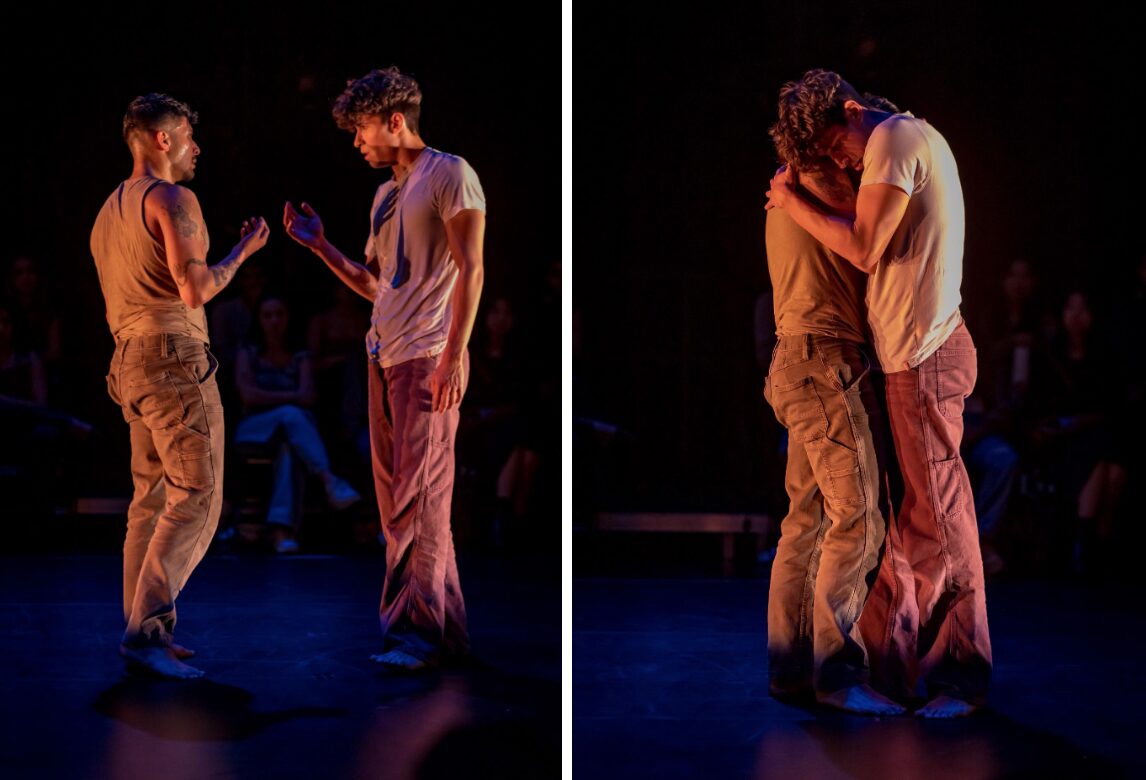I recently attended ACDA at El Camino College and watched one of the evening showcase performances. I wrote elsewhere about Human Animal, another piece which I found particularly compelling, but I want to write here about Bonds. The piece made a huge impression on me, and on the audience in general judging by the volume of cheers at its conclusion. Bond is a piece about queerness, masculinity, gender identity, and self-acceptance, and it had me sobbing by the end.
The excerpt of Bonds shown at ACDA involved two dancers, both the choreographer Jose Argueta and dancer Adrian Contreras, and the movement was acrobatic, sometimes even combative in its aggressive, reckless movement. It was truly exhilarating to watch such talented and athletic dancers such a level of artistry with their bodies—but, it would be misleading to characterize the dance as simply flash movements and crowd-pleasers. Instead, it was a deeply moving and emotional storyline.
The piece began with the two dancers executing circular and repeating movements around the stage. A recurring image of bent knees and splayed legs pervaded the movement, from when the dancers rolled on their backs on the ground with legs at angles, to when they execute a cartwheel with 90 degree knees. The movement was both traditionally masculine in its athleticism and attack, but also vulnerable in the openness of the legs and the softness of rolling on the back. This spoke to the conflict inherent for some their experiences of masculinity within queerness—to be soft yet strong.
The two dancers continued to circle each other, often repeating this motif, until suddenly Argueta left the movement cycle. Contreras then danced the motif alone, as Argueta wandered the stage in apparent confusion or rejection of participation in this shared choreography. This moment spoke to me about issue of self-rejection as relates to queerness, a story all-too-familiar to many LGBTIA people.
Then, Argueta rejoined the choreography but more aggressively this time. The two dancers appeared to fight, slamming into each other as they threw one another around the stage. This again seemed to speak to me of issues of self-acceptance vs. self-rejection as it relates to queerness, and especially within societal expectations of masculinity. It is all too easy to become not just strong, but rigid and cruel in the face of difficult emotion. It is easier to attack than to yield. The dancers seem to struggle to accept their queerness and instead fall back upon the more pathological aspects of societal expectations of masculine behavior—to be hard, rather than to be soft, and to fight rather than to understand.
The fight reached a crescendo as the two dancers move closer, then closer together. In the end, the two froze in an embrace. At this moment, the entire audience broke into cheers. There was a palpable support of this moment of self-acceptance and love.
The excerpt of Bonds shown at ACDA is part of a larger work which was shown as a part of Jose Argueta’s MFA work at the University of California, Irvine. Although there are no current bookings for the entire piece to be shown again, so far as I know, I hope that it will find another performance venue so that I (and others) will have the opportunity to see the work in its entirety. It is entirely worth experiencing, if you have the chance to see it.
Cover image is excerpted from “Bonds: Male Mentorship in Community Colleges through Autoethnographic Creative Processes,” by Jose Argueta.

Leave a Reply